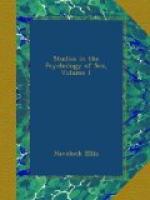I am far from wishing to deny that the impulse which draws young men and women to imaginative literature is unconnected with the obscure promptings of the sexual instinct. But, until the disturbing influence I have just pointed out is eliminated, I see no evidence here for any true seasonal periodicity. Possibly in prisons—the value of which, as laboratories of experimental psychology we have scarcely yet begun to realize—more reliable evidence might be obtained; and those French and other prisons where novels are freely allowed to the prisoners might yield evidence as regards the consumption of fiction as instructive as that yielded at Clermont concerning the consumption of bread.
Certain diseases show a very regular annual curve. This is notably the case with scarlet fever. Caiger found in a London fever hospital a marked seasonal prevalence: there was a minor climax in May (repeated in July), and a great autumnal climax in October, falling to a minimum in December and January. This curve corresponds closely to that usually observed in London.[170] It is not peculiar to London, or to urban districts, for in rural districts we find nearly the same spring minor maximum and major autumnal maximum. In Russia it is precisely the same. Many other epidemic diseases show very similar curves.
An annual curve may be found in the expulsive force of the bladder as measured by the distance to which the urinary stream can be projected. This curve, as ascertained for one case, is interesting on account of the close relationship between sexual and vesical activity. After a minimum point in autumn there is a rise through the early part of the year to a height maintained through spring and summer, and reaching its maximum in August.[171] This may be said to correspond with the general tendency found in some cases of nocturnal seminal emissions from a winter minimum to an autumn maximum.
There is an annual curve in voluntary muscle strength. Thus in Antwerp, where the scientific study of children is systematically carried out by a Pedological Bureau, Schuyten found that, measured by the dynamometer, both at the ages of 8 and 9, both boys and girls showed a gradual increase of strength from October to January, a fall from January to March and a rise to June or July. March was the weakest month, June and July the strongest.[172]
Schuyten also found an annual curve for mental ability, as tested by power of attention, which for much of the year corresponded to the curve of muscular strength, being high during the cold winter months. Lobsien, at Kiel, seeking to test Schuyten’s results and adopting a different method so as to gauge memory as well as attention, came to conclusions which confirmed those of Schuyten. He found a very marked increase of ability in December and January, with a fall in April; April and May were the minimum months, while




